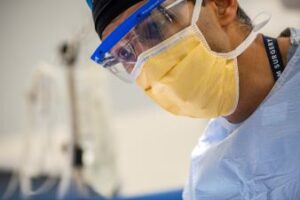
With about 12,000 to 13,000 cases diagnosed in the United States each year, sarcomas are among medicine’s rarest cancers. Since many oncologists may only see one or two cases during their career, patients often struggle to find experienced providers.
Sarcomas are also complex. There are more than 50 subtypes, they can occur anywhere in the body, and they exhibit vastly different behaviors.
“Sarcoma is not a single disease,” says Chandrajit P. Raut, MD, MS, chief of Surgical Oncology at Brigham and Women’s Hospital and Surgery director in the Center for Sarcoma and Bone Oncology at Dana-Farber Brigham Cancer Center. “The variability among sarcomas is striking.”
Managing Complex Sarcoma Cases a Team Effort
The high-volume Center for Sarcoma and Bone Oncology treats approximately 1,000 new patients every year. Its expanding group has three surgical oncologists, nine medical oncologists, two radiation oncologists, and two orthopedic oncologists dedicated exclusively to providing sarcoma care and working together to manage complex cases in a coordinated manner.
“Our surgical oncologists are supported on the frontline by a highly experienced team of anesthesiologists, plastic/reconstructive surgeons and other subspecialty surgeons, and OR and floor nurses who see and care for sarcoma patients every day,” Dr. Raut says. “Behind the scenes, we have a dedicated team of world-renowned sarcoma pathologists who are setting standards for sarcoma type identification and helping to define the field.”
Correctly diagnosing a patient’s sarcoma is crucial to proper treatment, and Dana-Farber Brigham’s sarcoma pathologists are integral to the Center for Sarcoma and Bone Oncology. They work in tandem with the surgical, medical, and radiation oncology teams daily to optimize care. They also are tasked with reviewing tissue samples obtained from biopsies or operations conducted at other hospitals. In about 25 percent of those assessments, the pathology team’s deep understanding of sarcoma types and their ability to identify subtle differences among them leads to patients receiving a different diagnosis. This, in turn, affects recommended chemotherapy, radiation, and surgery strategies.
Robust Tumor Bank Is a Foundation for Sarcoma Research
Because Dana-Farber Brigham sees a high volume of sarcoma patients every year, it has developed a large and robust sarcoma tumor bank. As a result, Dana-Farber Brigham physician-scientists are able to lead numerous clinical trials and other research projects focused on identifying and developing cutting-edge treatment strategies for individual sarcomas. In many trials, Dana-Farber Brigham collaborates with leading institutions worldwide, giving its researchers access to an even broader range of sarcoma tissue samples and sarcoma expertise.
The Dana-Farber Brigham sarcoma team was instrumental in a recent multinational phase 3 study to evaluate the impact of preoperative radiotherapy plus surgery versus surgery alone for patients with primary retroperitoneal sarcoma. The study was the first large, international, randomized trial in primary, localized retroperitoneal sarcoma to be successfully completed. With 43 months of follow-up, the trial was negative, showing similar abdominal recurrence-free survival in patients receiving surgery alone and in those receiving preoperative radiotherapy plus surgery. Similar overall survival was also observed in the two groups.
“We knew going into the study that radiation therapy reduces the risk of local recurrence in extremity soft tissue sarcomas, but we didn’t have evidence of efficacy for retroperitoneal sarcoma and therefore would have to extrapolate to justify its use,” Dr. Raut says. “We now suspect that due in part to the need to adjust and reduce doses of radiation around delicate abdominal organs, radiation it is not as effective as it is in extremity sarcomas, except perhaps in a small subset of patients.”
Active in Early-Phase Research as Well
In addition to leading clinical trials, Dr. Raut has a full slate of early-stage laboratory research focused on novel therapies to reduce the risk of local sarcoma recurrence.
In one proof-of-principle study, he and his colleagues synthesized and optimized a novel electrospun poly(caprolactone) surgical mesh coated with layers of a hydrophobic polymer to deliver the chemotherapy drug doxorubicin directly to the operative bed following sarcoma resection. The study demonstrated the approach to be therapeutically feasible in preventing postsurgical tumor recurrence and minimizing cardiotoxicity.
In another study, Dr. Raut and research colleagues studied intraoperative implantation of paclitaxel (PTX)-eluting polymer films to deliver sustained, supratherapeutic PTX concentrations. The latter were found to markedly decrease sarcoma lethality in vivo, making the approach an alternative paradigm for recurrence prevention.
“Oncologic outcomes can be inferior for patients with locally recurrent disease, even after macroscopically complete surgical resection,” Dr. Raut says. “New and emerging treatment modalities like those we are developing may someday improve these outcomes.”